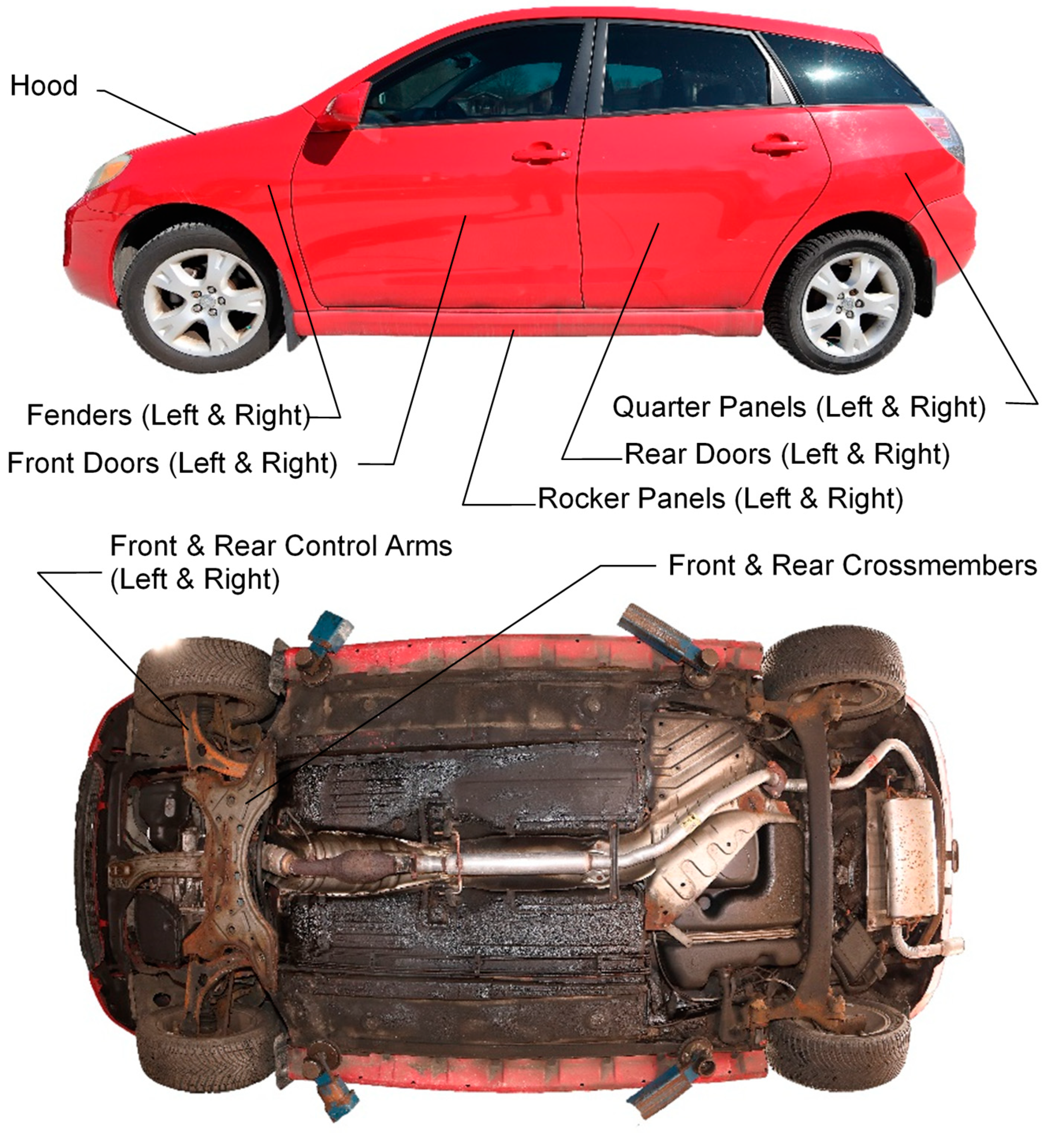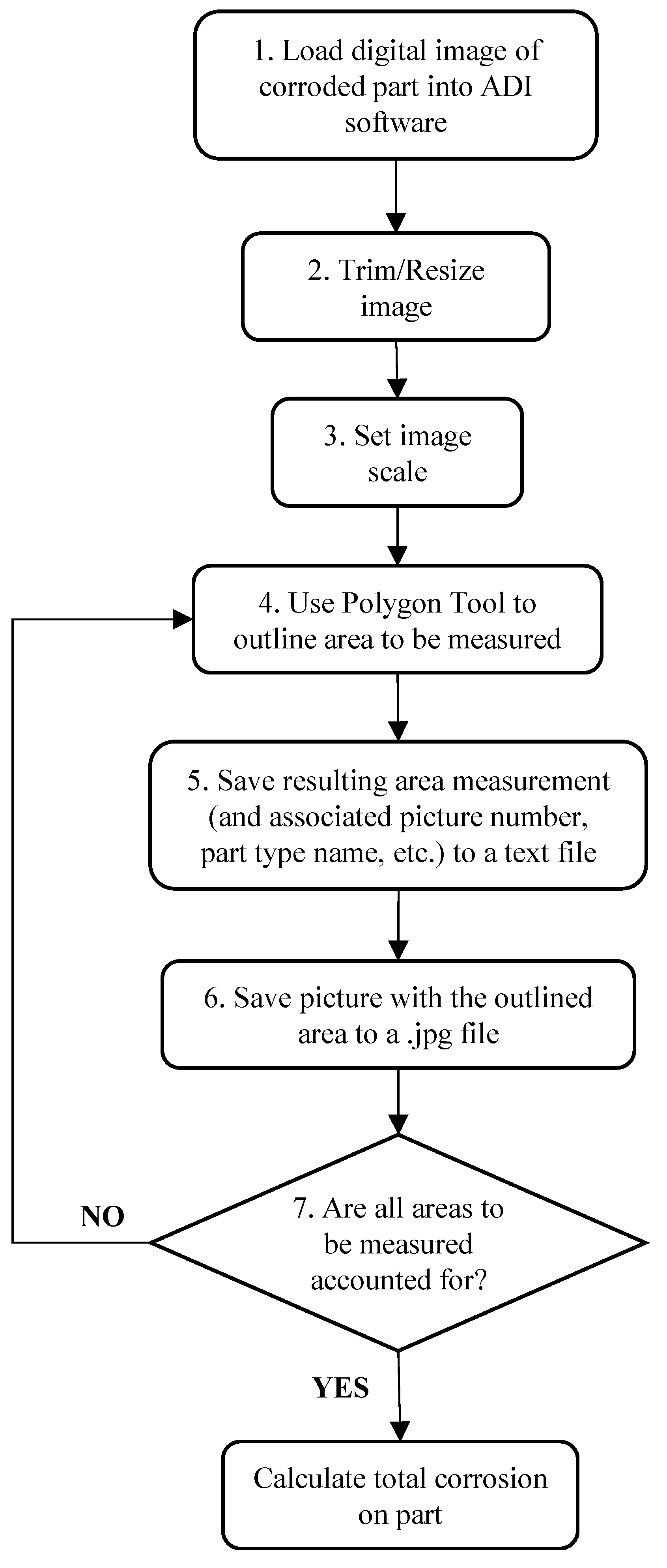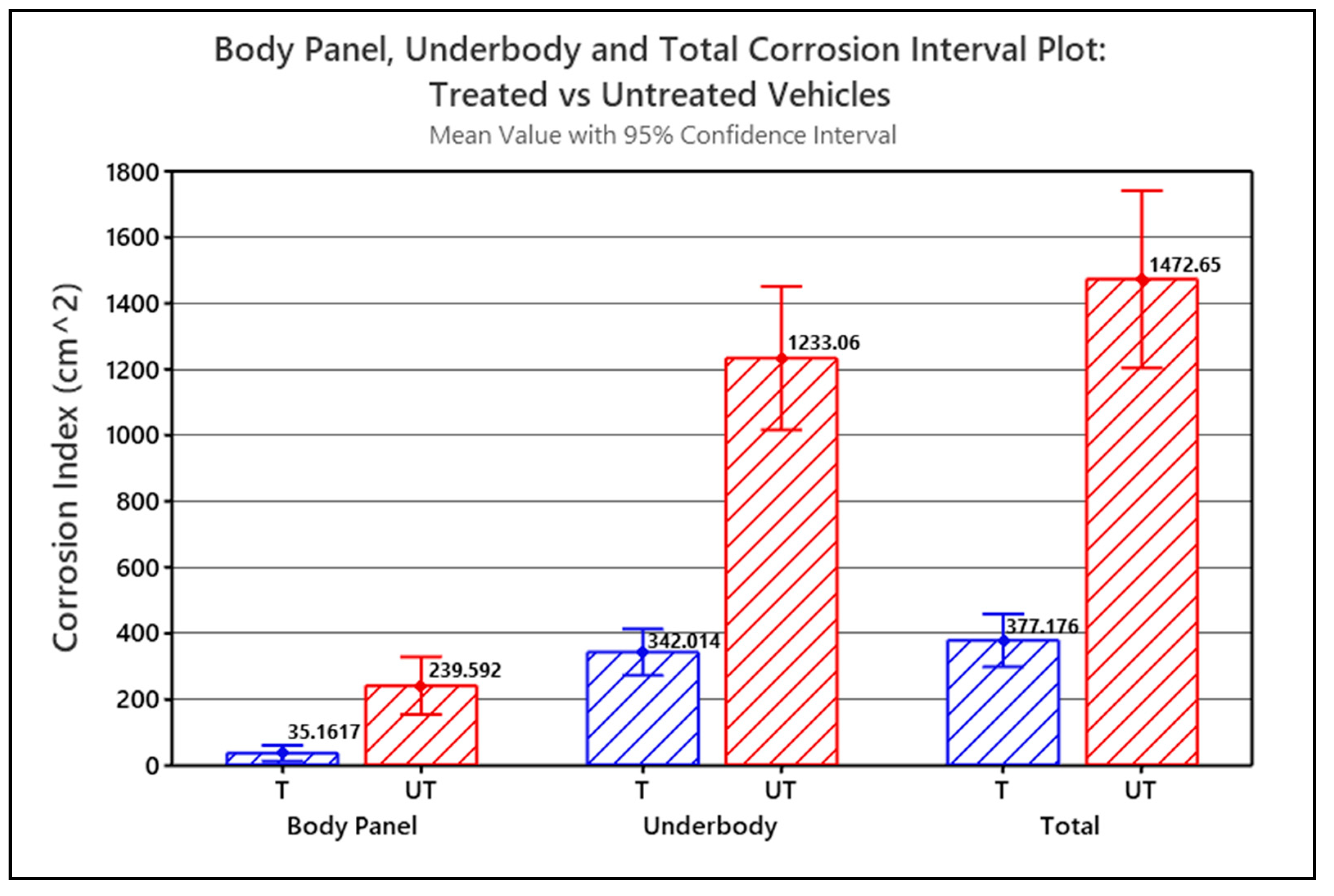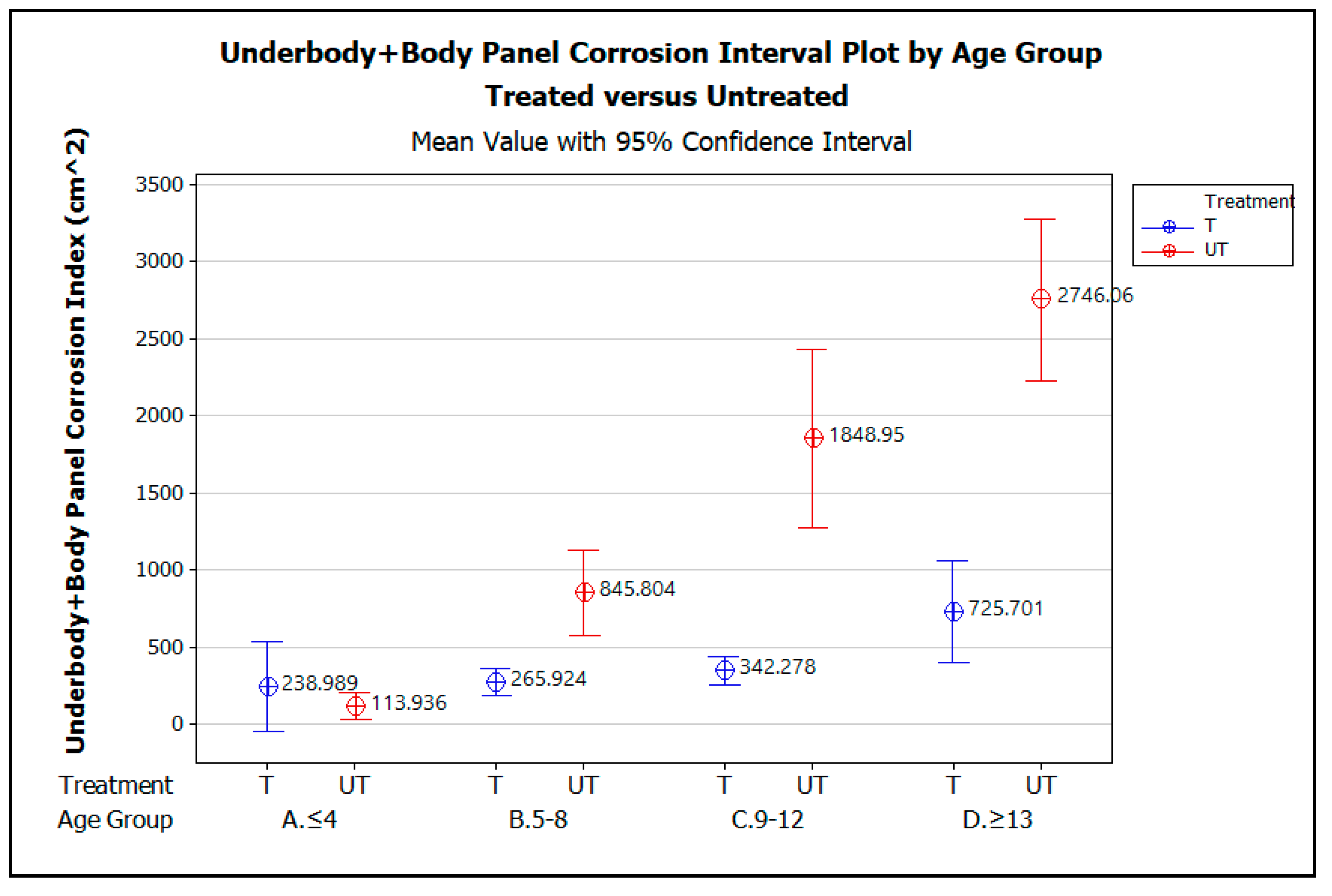Measuring Corrosion on Vehicles, in Real-Time, Using Digital Imaging and Analysis Techniques
Abstract
:1. Introduction
1.1. Corrosion Prevention and Development
- Pretreatment of the welded sheet metal automotive body structure, i.e., body-in-white (BIW);
- Electrodeposition (ED) of the anti-corrosion or rust prevention layer on the metal underbody and frames;
- Sealer application on seams and underbody (i.e., underbody coating or UBC);
- Primer application;
- Topcoat applications, i.e., basecoat and clearcoat [4].
1.2. Lab-Based Corrosion Testing
- K = the constant 3.45 × 106 mils per year (mpy),
- T = exposure time, in hours,
- A = area in cm2,
- W = mass loss in grams,
- D = density of the material tested in g/cm2.
1.3. Corrosion Measurement in the Field
- Thickness analysis
- 2.
- Surface-roughness analysis
- 3.
- Digital Image Analysis
1.4. Review Summary and Objectives
- Time-efficient. The technician assessing corrosion should be able to perform the assessment within a matter of minutes;
- Conceptually understandable. The technician should be able to grasp the basic approach of the corrosion technique and, if necessary, explain the fundamental premise to a vehicle owner, who also must, in turn, be able to understand and appreciate what is taking place. From this perspective, while it may be desirable to undertake a detailed corrosion assessment at the surface and below the surface for accuracy and precision, from an aftermarket or consumer perspective, this may not be necessary or even desirable: an approximate but workable measure of corrosion may be sufficient for the typical vehicle owner;
- Operationally functional. The mechanics of facilitating the assessment and the actual physical procedure performed by a technician (or even vehicle owner) must be able to conform to relatively restricted operating space (e.g., under a raised vehicle; unencumbered or untethered device; easy to repeat actions in tight spaces, etc.).
- Take pictures of the corroded parts and materials using a digital camera or camera-enabled device;
- Analyze the digital images using software to evaluate the corrosion level by:
- Detecting the presence of rusted areas in each digital image taken of each vehicle part;
- Determining the extent of rust and calculating the total rusted area versus non-rusted area within each image.
- Evaluate the overall corroded condition of the vehicles studied relative to vehicle make, model, model year, history of corrosion treatment, history of vehicle use and care, and so forth.
2. Materials and Methods
2.1. Measurement Process
2.2. Corrosion Assessment
- P = perforation area;
- Wp = weighting factor assigned to perforations;
- B = blister area;
- Wb = weighting factor assigned to blistering;
- S = surface rust area;
- Ws = weighting factor assigned to surface rust; and
- Wp = Wb = Ws = 1.
3. Results and Analysis
3.1. Single-Factor ANOVA: Corrosion Index versus Treatment
- If p ≤ α, the null hypothesis is rejected in favor of the alternative hypothesis. Meaning the differences between the means are statistically significant;
- If p > α, accept the null hypothesis as true, i.e., the differences between the means are not statistically significant.
3.2. Two-Factor ANOVA: Corrosion Index versus Vehicle Age Group and Treatment
4. Discussion
Error Sources
- Misidentification of a part; for example, a rear axle being mistaken for a rear crossmember;
- Pictures were taken at angles that deviated from 90° to the observation plane;
- Differences in how the corroded area measurements in the digital images could be undertaken. For example, in one method, corroded areas on a part are measured directly with the ADI software and were then summed. In a second method, corrosion-free areas were measured, summed, and subtracted from the overall part area. The operator’s interpretation of what was corroded or not corroded, as well as how precisely the areas of corrosion in the digital images were manually delineated using the measurement tools in the ADI software, could also differ.
- The use of an alternative aftermarket corrosion protection method, i.e., undercoating and/or cathodic/anodic protection devices, in combination with the Krown’s T40 corrosion treatment, may also introduce a bias in the comparisons between treated and untreated populations. According to the Phase II survey respondents (response rate = 87%), only 7% of the vehicles had received a combination of aftermarket corrosion treatments. To alleviate this source of bias, we defined treated vehicles as all vehicles having been treated with Krown’s T40, with or without the use of an alternative aftermarket corrosion protection method. In the future, such biases may be avoided by obtaining more samples of that group of vehicles and including the prior treatment as a factor in the ANOVA.
5. Conclusions
- Statistical analyses are being performed to study and identify factors with a significant influence on corrosion of treated versus untreated vehicles, as well as factors that do not. For example, ANOVA and/or correlation analyses will be performed to determine if any of the following factors significantly affect the incidence of corrosion on the targeted corrosion-prone parts of the treated and untreated vehicles:
- Vehicle age;
- Driving practices (e.g., city versus highway);
- Driving conditions (e.g., exposure to salted winter roadways or unpaved/gravel roadways);
- Storage practices (e.g., in a garage or not);
- Maintenance practices (e.g., frequency of washing), etc.;
- Using combinations of alternative aftermarket corrosion protection methods.
- Corrosion correlation analyses are being performed to determine if specific Body Panel or Underbody parts, or a combination of parts, can serve as a proxy for overall corrosion on a vehicle: in other words, can measuring one select part describe the state of corrosion for the entire vehicle meaningfully, and thus save measuring multiple body parts;
- Additional analysis techniques, such as the automated interpretation and assessment of color in digital images using a computer-based algorithm, are under development to reduce the reliance on the operator and thus decrease errors introduced by human judgment. While accepted imaging techniques were used, future research will focus on refining the capability to distinguish corrosion better using, for example, improved corrosion color recognition and analysis, as well as the development of a mobile platform for field deployment. Other possible corrosion assessment techniques, such as AI and Machine Learning (ML) approaches, will also be investigated in future research activities;
- The research provides statistically significant confirmation that the optical method of digitally recording and measuring corrosion on specified corrosion-prone parts of vehicles is feasible and that, in terms of corrosion, untreated vehicles fare worse in general than aftermarket-treated vehicles. Nevertheless, the method that has been developed for measuring vehicle corrosion would benefit from additional studies to mitigate errors. The corrosion measurement method can be refined, and error sources reduced. The resulting refined methodology would be tested and validated by sampling and analyzing the corrosion on another group/population of vehicles, e.g., 160 aftermarket corrosion treated vehicles and 160 untreated vehicles, with 40 vehicles in each of the four age groups, ≤4 yrs, 5–8 yrs, 9–12 yrs and ≥13 yrs. Two-way ANOVA would be used to determine if the refined method gives results with similar CI versus age-group trends and reduced confidence interval error bars.
Author Contributions
Funding
Institutional Review Board Statement
Data Availability Statement
Acknowledgments
Conflicts of Interest
References
- Koch, G.H.; Brongers, M.P.H.; Thompson, N.G.; Virmani, Y.P.; Payer, J.H. Corrosion Costs and Preventive Strategies in the United States; Report No. FHWA-RD-01-156; Prepared by CC Technologies Laboratories, Inc. and NACE International for the Office of Infrastructure Research and Development; United States Federal Highway Administration: McLean, VA, USA, 2001; 773p.
- Shi, X.; Li, Y.; Jungwirth, S.; Fang, Y.; Seeley, N.; Jackson, E. Identification and Laboratory Assessment of Best Practices to Protect DOT Equipment from the Corrosive Effects of Chemical Deicers; Report No. WA-RD 796.1; Washington State Department of Transportation, Office of Research & Library Services: Olympia, WA, USA, 2013; 217p.
- Johnson, J.T. Motor Vehicles, Appendix N, From Corrosion Costs and Preventive Strategies in the United States; Report No. FHWA-RD-01-156; Prepared by CC Technologies Laboratories, Inc. and NACE International for the Office of Infrastructure Research and Development; United States Federal Highway Administration: McLean, VA, USA, 2001; 773p.
- Akafuah, N.K.; Poozesh, S.; Salaimeh, A.; Patrick, G.; Lawler, K.; Saito, K. Evolution of the automotive body coating process—A review. Coatings 2016, 6, 24. [Google Scholar] [CrossRef] [Green Version]
- Okolisan, J. How to Protect Your Car against Road Salt and Prevent Rust. 2015. Available online: https://www.wheels.ca/guides/how-to-protect-your-car-against-road-salt-and-prevent-rust/ (accessed on 6 February 2020).
- Talbot, D.E.J.; Talbot, J.D.R. Corrosion Science and Technology, 3rd ed.; CRC Press: Boca Raton, FL, USA, 2018; Available online: https://app.knovel.com/hotlink/toc/id:kpCSTE0001/corrosion-science-technology/corrosion-science-technology (accessed on 6 February 2020).
- Colin Beresford, C.; Miller, C. Average Age of Vehicles on the Road Rises above 12 Years. Car and Driver. 2021. Available online: https://www.caranddriver.com/news/a33457915/average-age-vehicles-on-road-12-years/ (accessed on 3 August 2021).
- Bardal, E.; Drugli, J.M. Corrosion detection and diagnosis. In Materials Science and Engineering, Vol. III, Encyclopedia of Life Support Systems (EOLSS); Developed under the auspices of the, UNESCO; Rawlings, R.D., Ed.; EOLSS Publishers: Oxford, UK, 2004; Available online: http://www.eolss.net (accessed on 27 July 2020).
- Xi, Y.; Xie, N. Corrosion Effects of Magnesium Chloride and Sodium Chloride on Automobile Components; Report No. CDOT-DTD-R-2002-4; Colorado Department of Transportation Research Branch: Denver, CO, USA, 2002; 91p.
- J2334_199806; SAE International, 1998. SAE J2334 Laboratory Cyclic Corrosion Test, SAE Technical Standard. SAE International: Troy, MI, USA, 1998. [CrossRef]
- B117-19; B117-19 Standard Practice for Operating Salt Spray (Fog) Apparatus. ASTM International: West Conshohocken, PA, USA, 2011; 12p. Available online: https://doi-org.ledproxy2.uwindsor.ca/10.1520/B0117-11. (accessed on 8 May 2020).
- G28-97; G28-97 Standard Test Methods of Detecting Susceptibility to Intergranular Corrosion in Wrought, Nickel-Rich, Chromium-Bearing Alloys. ASTM International: West Conshohocken, PA, USA, 1997; 5p. Available online: https://doi-org.ledproxy2.uwindsor.ca/. (accessed on 8 May 2020).
- Hu, D. Developing a Consumer Oriented Metric for Measuring Corrosion on Vehicles. Master’s Thesis, University of Windsor, Windsor, ON, Canada, 2016; 112p. [Google Scholar]
- Yamana, M.; Murata, H.; Onoda, T.; Ohashi, T. Development of system for crossarm reuse judgment on the basis of classification of rust images using support vector machine. In Proceedings of the 17th IEEE International Conference on Tools with Artificial Intelligence (ICTAI’05), Hong Kong, China, 14–16 November 2005; pp. 402–406. [Google Scholar] [CrossRef]
- Hansen, J.P. Using Eddy Current for Corrosion Inspection, Inspection Trends; American Welding Society: Miami, FL, USA, 2007; pp. 29–31. Available online: https://app.aws.org/itrends/2007/10/it200710/it1007-29.pdf (accessed on 26 June 2020).
- Olympus (Olympus Corporation). Fuselage Inspection, ECA Subsurface Corrosion Detection. 2018. Available online: https://www.olympus-ims.com/en/.downloads/download/?file=285217227&fl=en_US (accessed on 23 June 2020).
- Olympus. Fastener Inspection, ECA Surface Crack Detection. 2018. Available online: https://www.olympus-ims.com/en/.downloads/download/?file=285214630&fl=en_US (accessed on 29 July 2020).
- Wright, M. Eddy Current Testing Technology, 1st ed.; Eclipse Scientific Inc.: Owen Sound, ON, Canada, 2015. [Google Scholar]
- Olympus. Corrosion Detection and Measurement Using Eddy Current Methods, Application Notes, Olympus Industrial Resources. 2020. Available online: https://www.olympus-ims.com/en/applications/corrosion-detection-eddy-current/ (accessed on 27 July 2020).
- CNC Cookbook. Complete Guide to Surface Finish Symbols, Charts, RA, RZ, Measurements, and Callouts. 2020. Available online: https://www.cnccookbook.com/surface-finish-chart-symbols-measure-calculators/ (accessed on 27 July 2020).
- Ghanta, S.; Karp, T.; Lee, S. Wavelet domain detection of rust in steel bridge images, Acoustics, Speech and Signal Processing (ICASSP). In Proceedings of the 2011 IEEE International Conference, Prague, Czech, 22–27 May 2011; pp. 1033–1036. [Google Scholar] [CrossRef]
- Lee, S. Digital image processing methods for bridge coating management and their limitations. J. Civ. Eng. Archit. 2011, 5, 39–47. [Google Scholar]
- Bonnin-Pascual, F.; Alberto, O. Corrosion Detection for Automated Visual Inspection, Developments in Corrosion Protection. 2014. Available online: https://www.intechopen.com/chapters/46235 (accessed on 17 July 2021).
- Khayatazad, M.; De Pue, L.; De Waele, W. Detection of corrosion on steel structures using automated image processing. Dev. Built Environ. 2020, 3, 100022. [Google Scholar] [CrossRef]
- Sharma, V.; Thind, T. Techniques for detection of rusting of materials using imagine process: A survey. Int. J. Emerg. Sci. Eng. 2013, 1, 60–62. [Google Scholar]
- ADI (AnalyzingDigitalImages). Global Systems Science (GSS) Home > Software > Download > AnalyzingDigitalImages. 2018. Available online: http://www.globalsystemsscience.org/software/download (accessed on 6 July 2020).
- Global Systems Science. Global Systems Science (GSS) Home > About. 2018. Available online: https://www.globalsystemsscience.org/about.html (accessed on 28 March 2022).
- Wang, Y.; Underhill, R.S.; Klassen, B. Review of Corrosion Control Programs and Research Activities for Army Vehicles; Defence Research and Development Canada—Atlantic: Dartmouth, NS, Canada, 2006. [Google Scholar]







| Body Panels: | Underbody: |
|---|---|
|
|
|
|
|
|
|
|
|
|
|
|
| |
| |
| |
| |
|
| ANOVA Scenario | 1 | 2 | 3 |
|---|---|---|---|
| ANOVA Statistics | Total Body Panel Corrosion vs. Treatment | Total Underbody Corrosion vs. Treatment | Total Underbody + Body Panel Corrosion vs. Treatment |
| Significance level α | 0.05 | 0.05 | 0.05 |
| F-value | 28.87 | 83.41 | 85.19 |
| p-value | <0.001 | <0.001 | <0.001 |
| R2 | 0.0729 | 0.1852 | 0.1884 |
| Adjusted R2 | 0.0704 | 0.1830 | 0.1862 |
| Sample Count—Treated | 228 | 228 | 228 |
| Sample Count—Untreated | 141 | 141 | 141 |
| Mean—Treated | 35.2 | 342.0 | 377.2 |
| Means—Untreated | 239.6 | 1233 | 1473 |
| Standard Deviation of the Mean—Treated | 185.1 | 535.7 | 612.8 |
| Standard Deviation of the Mean—Untreated | 524.5 | 1307 | 1615 |
| Underbody + Body Panel Corrosion vs. Treatment | |||
|---|---|---|---|
| ANOVA Statistics | Treated | Untreated | |
| Significance level α | 0.05 | ||
| F-value | 18.78 | ||
| P-value | <0.001 | ||
| R2 | 0.4655 | ||
| Adjusted R2 | 0.4551 | ||
| Sample Count, by Age Group | A. ≤4 yrs | 19 | 32 |
| B. 5–8 yrs | 81 | 36 | |
| C. 9–12 yrs | 86 | 30 | |
| D. ≥13 yrs | 42 | 43 | |
| Mean, by Age Group | A. ≤4 yrs | 238.98 | 113.93 |
| B. 5–8 yrs | 265.92 | 845.80 | |
| C. 9–12 yrs | 342.28 | 1848.95 | |
| D. ≥13 yrs | 725.70 | 2746.06 | |
Publisher’s Note: MDPI stays neutral with regard to jurisdictional claims in published maps and institutional affiliations. |
© 2022 by the authors. Licensee MDPI, Basel, Switzerland. This article is an open access article distributed under the terms and conditions of the Creative Commons Attribution (CC BY) license (https://creativecommons.org/licenses/by/4.0/).
Share and Cite
Sawyer-Beaulieu, S.; Tam, E.; Hussein, A. Measuring Corrosion on Vehicles, in Real-Time, Using Digital Imaging and Analysis Techniques. Materials 2022, 15, 3053. https://doi.org/10.3390/ma15093053
Sawyer-Beaulieu S, Tam E, Hussein A. Measuring Corrosion on Vehicles, in Real-Time, Using Digital Imaging and Analysis Techniques. Materials. 2022; 15(9):3053. https://doi.org/10.3390/ma15093053
Chicago/Turabian StyleSawyer-Beaulieu, Susan, Edwin Tam, and Abdulkadir Hussein. 2022. "Measuring Corrosion on Vehicles, in Real-Time, Using Digital Imaging and Analysis Techniques" Materials 15, no. 9: 3053. https://doi.org/10.3390/ma15093053
APA StyleSawyer-Beaulieu, S., Tam, E., & Hussein, A. (2022). Measuring Corrosion on Vehicles, in Real-Time, Using Digital Imaging and Analysis Techniques. Materials, 15(9), 3053. https://doi.org/10.3390/ma15093053






